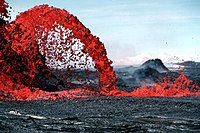
Photo from wikipedia
Abstract We conduct analogue experiments using starch and water mixture to understand the key factors controlling morphological transitions from colonnade to entablature of columnar joints. Columnar joints are formed by… Click to show full abstract
Abstract We conduct analogue experiments using starch and water mixture to understand the key factors controlling morphological transitions from colonnade to entablature of columnar joints. Columnar joints are formed by volume contraction during cooling. The isotherms are assumed to be perpendicular to the direction of the columns. However, observations of the morphological transition between colonnade and entablature and morphology in the entablature part are complex; it is expected that their formations are caused by a change in the distribution of the isotherms. Analogue experiments using starch and water mixtures have been conducted to reproduce the formation of colonnade (straight columns) but not for curved structures. We conduct experiments to reproduce the curved structures and investigate the process of crack propagation from two non-parallel drying surfaces and the relationship between the water distribution and crack development in the starch and water mixture by observing X-ray computed tomography (CT) images over time. In addition, the numbers of columns and cross-sectional areas are measured to interpret the column nucleation, which causes a decrease in the average column width. Based on analytical and numerical solutions of a simple diffusion equation, we examine the effect of critical temperature for crack initiation on curved structures, with a discussion comparing experimental results. The results and discussions suggest that 1) the curvature in crack development is likely controlled not only by the isotherm but also by the temperature at crack initiation and 2) an instantaneous increase in the cooling rate induces the column nucleation at the crack front. Finally, we propose a scenario of morphological transition from colonnade to entablature at Shakushiiwa, Aso-4 welded tuff, in Japan, which shows a threefold structure (upper colonnade – entablature – lower colonnade) based on our experimental results. We introduce two modes of heat transfers: vertical heat transfer Qd within intact rocks by thermal diffusion toward the upper cooling surface and horizontal heat transfer Qv through the cracks. The transition between the modes induces a drastic change in the shape of the isotherm at the crack front, resulting in the morphological transition from colonnade to entablature.
Journal Title: Journal of Volcanology and Geothermal Research
Year Published: 2020
Link to full text (if available)
Share on Social Media: Sign Up to like & get
recommendations!